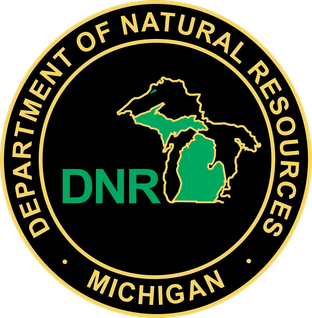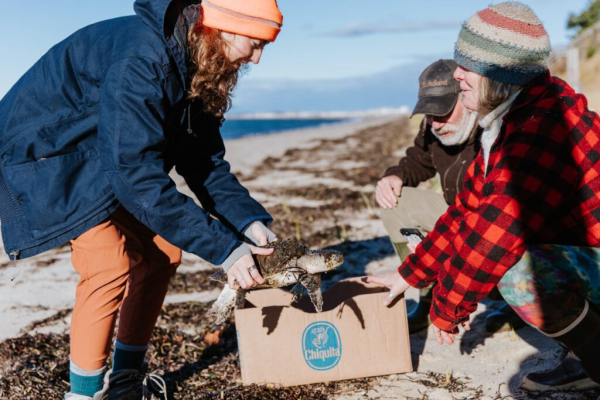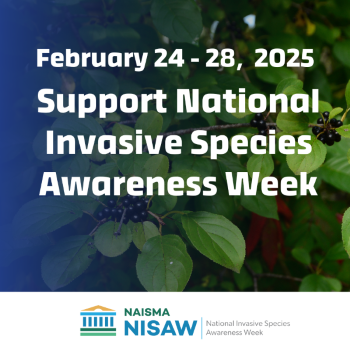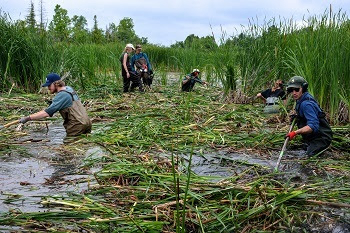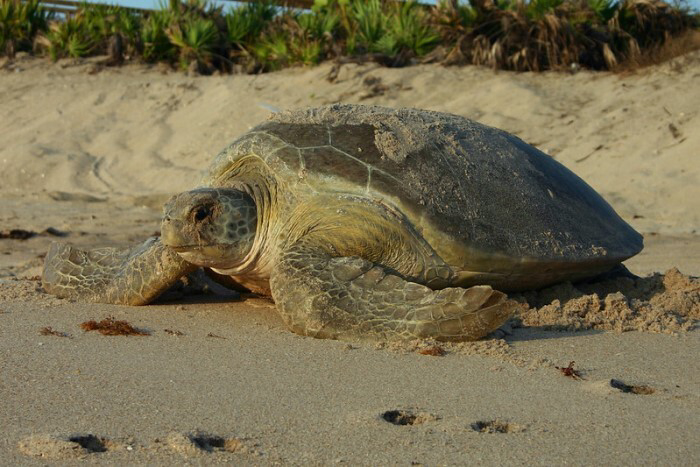MI DNR teaching teachers, connecting conservation to classrooms

At first they trickled in.
But as the time approached 10 o’clock, the audience began to swell.
Once the seating was gone, teachers began to stand around the edge of the room.
“If this session was titled ‘Oak Wilt and You,’ how many of you would be here,” asked Kevin Frailey, Michigan Department of Natural Resources education services manager.
One teacher in the crowded room raised her hand.
“I thought so,” Frailey said.
He then began his session titled “Invasive Monsters of the Deep,” which featured live sea lampreys. Frailey said one of the keys to guaranteeing a large audience is a creative program title.
With more than 1,800 teachers attending the annual Michigan Science Teachers Association’s Conference in March, competition among the speakers and their sessions was friendly, yet fierce.
However, each year the DNR packs them in. Nearly 300 teachers came to at least one of seven DNR conference sessions this past year in Lansing.
The event provided a rare opportunity for Frailey to co-present with his daughter, Tori, a senior biology student at Grand Valley State University and the day’s official lamprey handler.
The presentations may be brief – 45 minutes – but they’re still powerful.
“We look at these sessions at education conferences as critical to our mission,” said Natalie Elkins, Frailey’s colleague at the DNR and a K-12 education specialist.
The sessions are an introduction to the information, programs and materials the DNR can provide Michigan educators.
“Sea lamprey are the gateway animal to talk to your students about Michigan’s invasive species,” Frailey told his audience. His daughter circulated the room with the live eel-like creature attached to her hand, drawing nervous whispers from the crowd.
“Once you have your kids excited, and this critter will do it, your students will listen to you talk about any invasive species and their damage to our ecosystem, even oak wilt,” Frailey said.
The lone teacher who had raised her hand was Heather Peterson from Holt High School, a past National Biology Teacher of the Year and a big fan of the DNR sessions at the conference.
“I always attend them. In this case, invasive species are the perfect opportunity to teach current standards, including critical thinking and problem solving,” Peterson said. “You do not want to miss a session from the DNR at any professional opportunity, especially the Michigan Science Teachers Association’s Conference.”
As Frailey’s session concluded and the 76 teachers filed out of the room, Elkins began setting up for the next offering, an overview of new conservation education lessons and activities from the Association of Fish and Wildlife Agencies.
“Presentations at conferences like this may be brief, but they lead teachers down a pathway to our lengthier and more engaging professional development workshops like Project WILD and Project Learning Tree,” Elkins said.
Teachers learning a Project WILD activity.Elkins is the statewide coordinator for Project WILD, one of America’s best-known supplemental education programs, which has an emphasis on wildlife management, tied to Michigan schools’ life science standards.
Elkins and DNR colleague Ada Takacs, who coordinates Project Learning Tree, use the same popular format, offering teachers four- to six-hour workshops around the state.
Last year, more than 400 Michigan teachers were certified in Project Learning Tree and 617 in Project WILD. Both of these in-depth workshops include indoor classroom and outdoor field time.
“Connecting schools to trees, forests and forest management is an important component of Project Learning Tree” Takacs said. “The DNR manages more state-managed forests than nearly any state in America and our children should understand the resources we hold for them in public trust.”
Not all educators who attend these workshops need be long-time teachers.
Elkins and Takacs offer their workshops in many Michigan colleges and universities to preservice teachers.
Reena Abi-Akar, one such student at the University of Michigan, recently attended a Project WILD workshop.
“It will significantly broaden my skills and resources in environmental education,” she said.
And if four to six hours of wildlife and forestry education aren’t enough for teachers?
“That’s where we really amp it up,” Frailey said. “The short sessions at conference lead educators down the path to the workshops and the workshops lead teachers down the path to the academy.”
The academy is the DNR’s Natural Resources Academy, a weeklong summertime immersion into natural resources and their management, better known simply as “ANR.”
The DNR’s predecessor – the Michigan Department of Conservation – began a program back in the 1940s to educate Michigan teachers about the state’s valuable resources.
The Teachers Environmental School ran for more than five decades before finally coming to an end about 12 yearsIn a black-and-white photograph, teachers are shown at ago due to lack of participation with partnering colleges and universities.
But in 2008, the DNR resurrected the idea and created the Academy of Natural Resources, initially with 16 educators. Today, the academy usually serves about 60 teachers each summer. For one week they convene at the DNR’s Ralph A. MacMullan Conference Center, situated along the north side of Higgins Lake.
The facility, better known as “the RAM,” has been host to thousands upon thousands of Michigan teachers since the late 1940s.
“The academy’s first-year participants nicknamed their experience ‘RAM Camp’ because it brought back such great memories of outdoor education (they experienced) as youngsters,” said Jon Gray, a Michigan middle school teacher and long-time supporter of the academy. “We often hear teachers say this is the best professional development program they have ever experienced. Connecting teachers to Michigan’s resources, factual science expertise from professionals and lots of time in the field is one reason Safari Club International supports the program.”
The Novi Chapter of SCI has supported the academy for years and has offered scholarships to teachers totaling more than $50,000.
“When you consider each teacher, in turn, can impact 30 to 150 students a year, we think that is a great return on investment,” said Gray, who has acted as the conduit for funding from SCI.
All the partners involved play instrumental roles in the academy.
The American Institute of Professional Geologists (Michigan Chapter) also has pledged scholarships for the past four years, and Ferris State University works with the academy to provide graduate credits for teachers who need them.
Cindy Fitzwiliams-Heck, a biology faculty member at Ferris, went from academy participant in 2012 to becoming a member of the academy’s core planning team.
“I attended ANR so I could learn how the DNR manages our resources and how I could relate that information to my students at Ferris. It was such a valuable experience that I knew FSU had to become involved,” she said. “Now I coordinate the credit portion of the program and help teach each summer as well. Don’t raise your hand at ANR or ‘Headmaster Frailey’ will find something for you to do.”
The academy started with an opportunity for teachers to get certified in multiple conservation education curricula Four teachers wearing waders are standing in a stream at the Academy of Natural Resources, their first such waders experience.like Project WILD, Project Learning Tree and others like Project WET and the Leopold Education Project.
But each year, the core planning team has come up with another themed course, now eight in all. They each have a different emphasis, and the Michigan Department of Education approves continuing education credits for Michigan educators who attend.
Becky Durling, a past Michigan Elementary Science Teacher of the Year, has been to the academy for four consecutive years.
“Each summer I come home with tons of activities, curricula and resources that directly apply to my early childhood classroom in Williamston,” Durling said. “I have also made awesome personal and professional connections with teachers, non-formal educators and other experts.”
The DNR provides many of those experts.
The most popular session, or track, at the academy is “Forests, Fields and Fins,” which offers a day each in the field or forest or river with management professionals from fisheries, wildlife and forestry.
Even DNR conservation officers fill an important piece of the agenda. With realistic poaching crime scenes constructed, the COs point out the science behind forensics and evidence gathering. Teachers even have to write warrants and present their evidence in a mock courtroom setting.
The DNR’s direct connections to Michigan teachers through professional development are imperative, according to Frailey.
“Most of our agency staff focuses on protection and management of our vital natural resources, but professional development experiences make what they do as scientists relevant to the general population,” Frailey said. “Teachers are our best tool to do that.”
Perhaps Bill Hodges, a biology teacher from Holt High School, said it best.
“Many of today’s students are losing touch with their natural surroundings. They are tied to screens – phone screens, computer screens, television screens – and do not spend much time outside,” Hodges said.
Hodges said all of the DNR’s teacher education programs – especially the academy – provide instructors with the tools and the ideas to allow them to teach the state science curriculum through outdoor investigations, allowing students to experience the wonders of their natural world.
He concluded, “If they do not learn to appreciate nature, they will not value it, and if they don’t value it, they will not protect it.”
For more information, visit the DNR’s Education and Outreach Web page.



